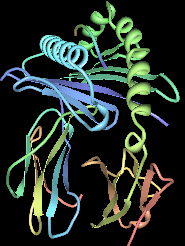HLA-B27

| ||
| B*2705-β2MG with bound peptide 2bst | ||
major histocompatibility complex (human), class I, B27
| ||
| Alleles | B*2701, 2702, 2703, . . . | |
| Structure (See HLA-B) | Available 3D structures | |
| EBI-HLA | B*2701 | |
| B*2702 | ||
| B*2703 | ||
| B*2704 | ||
| B*2705 | 2bsr, 2bss, 2bst, 2a83, 1w0v, 1uxs, 1ogt, 1hsa, 1jgd, 1jge | |
| B*2706 | ||
| B*2709 | 1w0w, 1uxw, 1of2, 1k5n | |
Human leukocyte antigen (HLA) B27 (subtypes B*2701-2759) [1] is a class I surface antigen encoded by the B locus in the major histocompatibility complex (MHC) on chromosome 6 and presents antigenic peptides (derived from self and non-self antigens) to T cells. HLA-B27 is strongly associated with ankylosing spondylitis (AS), and other associated inflammatory diseases referred to as "spondyloarthropathies". Diseases associated with the HLA-B27 subtype can be remembered with the mnemonic PAIR, and include Psoriasis, Ankylosing spondylitis, Inflammatory bowel disease, and Reactive arthritis.
The prevalence of HLA-B27 varies markedly in the general population. For example, about 8% of Caucasians, 4% of North Africans, 2-9% of Chinese, and 0.1-0.5% of persons of Japanese descent possess this gene.[1] In northern Scandinavia (Lapland), 24% of people are HLA-B27 positive, while 1.8% have associated ankylosing spondylitis.
A small group (<0.5%) of people infected with HIV are able to remain symptom-free for many years without medication. These long-term nonprogressors appear to be slightly[vague] more common among people who are HLA-B27 positive.[2]
Disease associations
The relationship between HLA-B27 and many diseases has not yet been fully elucidated. Though it is associated with a wide range of pathology, particularly seronegative spondyloarthropathy, it does not appear to be the sole mediator in development of disease. For example, while 90% of people with ankylosing spondylitis (AS) are HLA-B27 positive, only a fraction of people with HLA-B27 ever develop AS. People who are HLA-B27 positive are more likely to experience early onset AS than HLA-B27 negative individuals.[3] There are additional genes being discovered that also predispose to AS and associated diseases.[4] Additionally there are potential environmental factors (triggers) that may also play a role in susceptible individuals.[1]
Pathological mechanism
Due to its strong association with spondyloarthropathies, HLA-B27 is the most studied HLA-B allele. It is not entirely clear how HLA-B27 influences disease, however there are some prevailing theories as to the mechanism. The theories can be split into antigen-dependent and independent theories.[5]
Antigen-dependent theories
These theories consider a specific combination of antigen peptide sequence and the binding groove (B pocket) of HLA-B27 (which will have different properties to the other HLA-B alleles). The arthritogenic peptide hypothesis suggests that HLA-B27 has a unique ability to bind antigens from a microorganism that trigger a CD8 T-cell response that then cross-reacts with a HLA-B27/self-peptide pair. Furthermore, it has been shown that HLA-B27 can bind peptides at the cell surface.[6] The molecular mimicry hypothesis is similar, however it suggests that cross reactivity between some bacterial antigens and self peptide can break tolerance and lead to autoimmunity.[5]
Antigen-independent theories
These theories refer to the unusual biochemical properties that HLA-B27 has. The misfolding hypothesis suggests that slow folding during HLA-B27's tertiary structure folding and association with β2 microglobulin causes the protein to be misfolded, therefore initiating the unfolded protein response (UPR) - a pro-inflammatory endoplasmic reticulum (ER) stress response. However, although this mechanism has been demonstrated both in vitro and in animals, there is little evidence of its occurrence in human spondyloarthritis.[6] Also, the HLA-B27 heavy chain homodimer formation hypothesis suggests that B27 heavy chains tend to dimerise and accumulate in the ER, once again, initiating the UPR.[5] Alternatively, cell surface B27 heavy chains and dimers can bind to regulatory immune receptors such as members of the killer cell immunoglobulin-like receptor family, promoting the survival and differentiation of pro-inflammatory leukocytes in disease.
Associated pathology
In addition to its association with ankylosing spondylitis, HLA-B27 is implicated in other types of seronegative spondyloarthropathy[7] as well, such as reactive arthritis (Reiter's Syndrome), certain eye disorders such as acute anterior uveitis and iritis, psoriatic arthritis and ulcerative colitis associated spondyloarthritis. The shared association with HLA-B27 leads to increased clustering of these diseases.[8]
See also
External links
- HLA-B27 Syndromes at eMedicine by A. Luisa Di Lorenzo, MBBCh
- Bowness P (2002). "HLA B27 in health and disease: a double-edged sword?". Rheumatology (Oxford). 41 (8): 857–68. doi:10.1093/rheumatology/41.8.857. PMID 12154202.
- Online Mendelian Inheritance in Man (OMIM): 142830
- HLA-B27 at the U.S. National Library of Medicine Medical Subject Headings (MeSH)
- BASDAI and Ankylosing Spondylitis
References
- ^ a b c M. A. Khan (2010). "HLA and spondyloarthropathies". In Narinder K. Mehra (ed.). The HLA Complex in Biology and Medicine. New Delhi, India: Jayppee Brothers Medical Publishers. pp. 259–275. ISBN 978-81-8448-870-8.
- ^ Deeks, S. G., Walker, B. D. Human Immunodeficiency Virus Controllers: Mechanisms of Durable Virus Control in the Absence of Antiretroviral Therapy. Immunity, 2007, 27: 406-416
- ^ Feldtkeller, Ernst; Muhammad, Khan; van der Heijde, Desiree; van der Linden, Sjef; Braun, Jurgen (2003). "Age at disease onset and diagnosis delay in HLA-B27 negative vs. positive patients with ankylosing spondylitis". Rheumatology International. 23 (2): 61–66.
{{cite journal}}:|access-date=requires|url=(help) - ^ Thomas GP, Brown MA. Genetics and Genomics of Ankylosing Spondylitis. Immunol Rev. 2010; 233:162-180.
- ^ a b c Hacquard-Bouder, C., Ittah, M., Breban, M. Animal models of HLA-B27 associated diseases:new outcoumes. Joint Bone Spine, 2005, 73: 132-138
- ^ a b Bowness, Paul (2015-01-01). "HLA-B27". Annual Review of Immunology. 33: 29–48. doi:10.1146/annurev-immunol-032414-112110. ISSN 1545-3278. PMID 25861975.
- ^ Elizabeth D Agabegi; Agabegi, Steven S. (2008). Step-Up to Medicine (Step-Up Series). Hagerstwon, MD: Lippincott Williams & Wilkins. ISBN 0-7817-7153-6.
{{cite book}}: CS1 maint: multiple names: authors list (link) - ^ Kataria, RK; Brent LH (June 2004). "Spondyloarthropathies". American Family Physician. 69 (12): 2853–2860. PMID 15222650.
